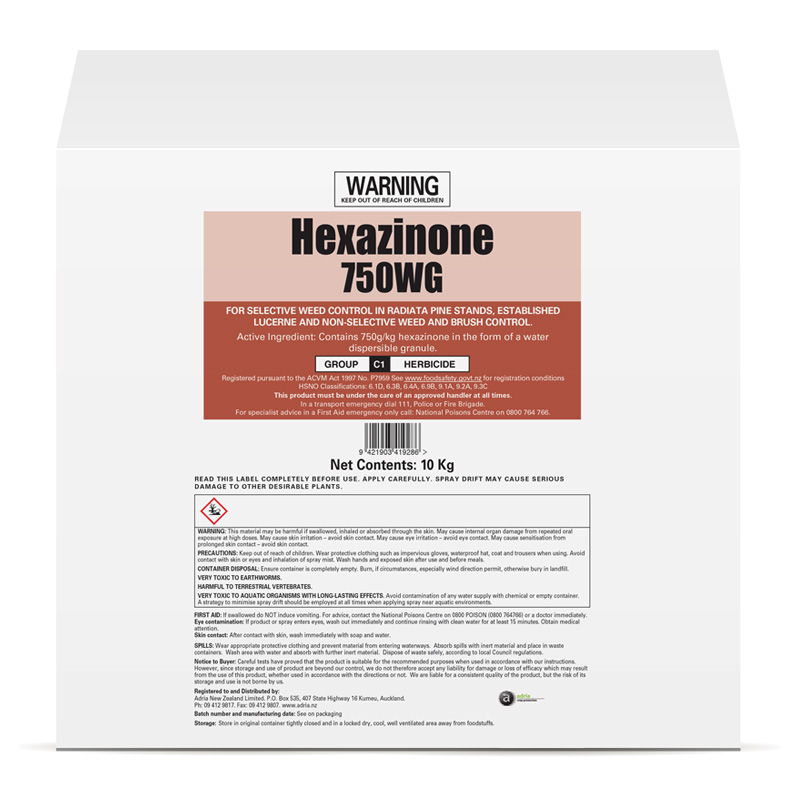POTATOES
| USE |
SITUATION |
RATE |
CRITICAL COMMENTS |
| Haulm destruction |
Very dense haulms |
Two applications 7 to 10 days apart in 600 to 1100 litres/ha. 1st application 3 to 4 litres/ha. 2nd application 1.5 to 3 litres/ha. OR 4 to 6 litres in 900 to1100 litres of water/ha as a single application. |
As a general guide DIQUAT 200SL should be applied to the crop about 14 days before proposed harvesting date. Leaf kill following DIQUAT 200SL treatment is rapid and usually complete after four days, but stem kill will take up to 14 days, depending on such factors as density of haulms and weather conditions following spraying (kill is more rapid during bright weather). Under conditions of hardened top growth, the split application is preferable for best results. |
| Haulm destruction |
Moderate to sparse haulms |
3 to 4 litres in 600 to 1100 litres of water/ha. |
Single application satisfactory. |
| Pre-Digging Weed control |
Broadleaf weeds only |
3 to 4 litres in 350 to 450 litres of water/ha. |
Where digging has been postponed for an extended period, weed growth may need to be removed to provide a clean harvest. A non- ionic wetting agent MUST be added at label rates. |
| Pre-Digging Weed control |
Broadleaf and grass weeds |
1.5 to 2 litres PARAQUAT (25% A.I.) plus 1.5 to 2 litres DIQUAT 200SL in 350 to 450 litres of water/ha. |
A non-ionic wetting agent MUST be added at label rates. |
Notes: DIQUAT 200SL is NOT recommended for use on the Rua variety. The rate of DIQUAT 200SL necessary will be governed by the vigour and density of the haulm at the time desiccation is required. Potato varieties with vigorous, dense tops such as Sebago and Tahi may require two applications applied 7 to 10 days apart to ensure complete spray penetration. Avoid application of DIQUAT 200SL to potatoes when the haulms are heavily laden with early morning dew. This can cause the chemical to be shed, leading to poor leaf desiccation. During prolonged dry periods the use of any haulm destroyer may damage the tubers. DO NOT spray when the soil is very dry. DO NOT use a wetting agent with DIQUAT 200SL for potato haulm applications.
CROPS
| CROP |
USE |
RATE |
CRITICAL COMMENTS |
| Barley, Wheat Note: Oat crops grown for stock feed may be Similarly treated but not used for Human consumption. |
Pre-harvest crop and weed desiccation. |
Aerial – apply 3 to 4 litres in a minimum of 350 litres of water/ha. (Non-ionic wetting agent MUST be used at label rates.) |
To remove weeds, hasten maturity and reduce the risk of harvesting losses from adverse weather. Weeds growing in a fully matured crop may be desiccated to allow clean bulk harvesting. |
| Green Beans, Lentils, Peas, Soya Beans |
As a desiccant and also to remove weeds and prevent secondary crop growth. |
3 to 4 litres in 300 to 350 litres of water/ha. Aeria l- a minimum of 4 litres in 350 litres of water/ha (Non-ionic wetting agent MUST be used at label rates.) |
Apply 7 days prior to harvesting, as soon as the seeds are fully developed and the pods are drying. |
| Lucerne, Red Clover, White Clover |
Dessication |
3 litres in 300 to 350 litres of water/ha. (Non-ionic wetting agent MUST be used at label rates.) |
As soon as the seed from the main flowering has matured, further crop growth can be halted in preparation for harvest. |
AQUATIC WEED CONTROL
| SITUATION |
WEEDS CONTROLLED |
RATE |
CRITICAL COMMENTS |
| Lakes and ponds (still water) |
Controls a range of aquatic weeds including: Canadian pondweed (Elodea canadensis), Lagarosiphon (Lagarosiphon major), Pondweeds (Potamogeton crispus and Potamogeton ochreatus), Hornwort (Ceratophyllum demersum) |
Boom – 30 litres per hectare. Handgun – 2 litres /100 litres of water, applying 1.5 litres of spray mix / 10 square metres. |
In boom application from aircraft or boat, use sufficient water to obtain even coverage. Alternatively, apply below surface using trailing nozzles behind a mobile platform. |
| Drains and waterways (flowing water) |
Controls a range of aquatic weeds including: Canadian pondweed (Elodea canadensis), Lagarosiphon (Lagarosiphon major), Pondweeds (Potamogeton crispus and Potamogeton ochreatus),Hornwort (Ceratophyllum demersum) |
30 litres per hectare. |
Apply by trailing nozzles below surface behind a mobile platform, or broadcast spraying (travelling upstream) is recommended. DO NOT treat where water is flowing at more than 1 km per hour (30cm / sec). |
DIQUAT 200SL is recommended and approved for use in lakes and waterways for the control of weeds growing below the water surface (i.e. submerged weeds). For control of grass and broadleaf weeds growing on drain banks and also above the water surface (emergent weeds), refer to paraquat labels.
WARNING: Injections from a fixed point must NOT be made. When applied to any natural water, treated water must NOT be bathed in, used for human consumption, fish farming or livestock watering for 24 hours after application. In a lake or any standing water, to maintain adequate oxygen supply to fish, NOT more than one quarter of the area should be treated at one time. Treated still water should NOT be used for overhead irrigation, until 10 days after treatment. However, water from a flowing water course may be used 24 hours after treatment. Consult the appropriate Regional Council before discharging DIQUAT 200SL into natural water.
NOTES: DIQUAT 200SL is NOT effective in turbulent, muddy water or where suspended organic matter is above 1 ppm. Treatment is best when water levels are at their lowest and temperatures at their highest. DIQUAT 200SL at the recommended rates is not toxic to fish. A non-ionic wetting agent should be added to DIQUAT 200SL at label rates for aerial application, but it is not required when using the injection technique.
MIXING: Use clean water only (dirty water will interfere with the action of the chemical). Partly fill spray tank with water, add the DIQUAT 200SL and add a non-ionic wetting agent (where recommended), mix, then top up with water to required volume.
APPLICATION: Conventional spray equipment may be used for application. In all cases complete coverage is essential. For boom spraying use a minimum of 300 litres of water per hectare, but up to 1100 litres per hectare may be necessary when using for “Potato Haulm Destruction” (refer to specific directions above). After use, wash out all spraying gear with 2 or 3 changes of clean water.
WETTING AGENT: DIQUAT 200SL contains no wetting agent and a non-ionic wetting agent MUST be added to the spray mixture at label rates, with the exception of the following uses:
- Potato Haulm Destruction – DO NOT add a wetting agent.
- Submerged Aquatic Weed Control (Injection Method) – DO NOT add a wetting agent.
WITHHOLDING PERIODS: Beans, Lentils Peas….7 days
Registered pursuant to the ACVM Act 1997, Approval No. P8006







